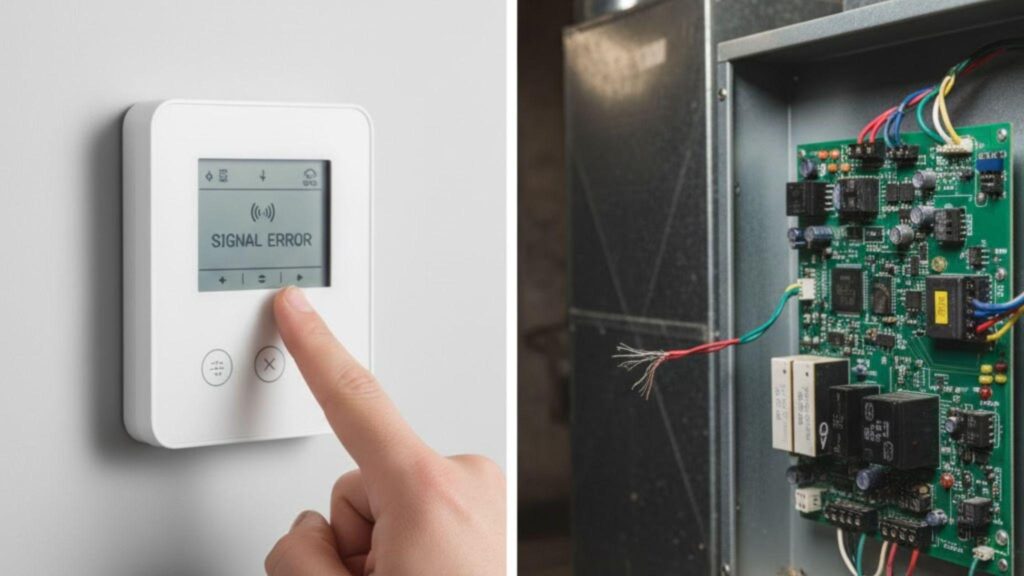A furnace not responding to thermostat adjustments usually indicates a breakdown in communication between the two devices. The thermostat acts as the command center, sending signals to the furnace to start or stop heating. If the furnace fails to respond, the issue could be as simple as dead batteries in the thermostat or as complex as a faulty control board inside the furnace.
In many cases, homeowners first notice the problem when the furnace fails to turn on, produces no heat, or cycles irregularly. These symptoms highlight the importance of checking both the thermostat and the furnace system to identify the root cause.
What are the Most Common Furnace Thermostat Issues?
One of the most frequent problems is thermostat malfunction, which can prevent the furnace from receiving the correct signals. Dust buildup, wiring issues, or outdated thermostat models can all contribute to this problem. Smart thermostats, while efficient, can also experience connectivity issues with Wi-Fi or compatibility problems with older furnace systems.
Another common issue is incorrect thermostat settings. If the thermostat is set to “cool” instead of “heat,” or if the temperature is set too low, the furnace will not activate. Homeowners should also check for tripped circuit breakers or blown fuses, as these can interrupt the power supply to the furnace.
Could a Furnace Not Heating Properly be Related to Airflow?
Yes, restricted airflow is a major factor when a furnace is not heating properly, which coincides with thermostat issues. Dirty air filters, blocked vents, or closed dampers can prevent warm air from circulating effectively. This can cause the furnace to overheat and shut down prematurely, leading to inconsistent heating.
Regular maintenance, such as replacing filters and ensuring vents are clear, helps prevent these airflow-related problems. In some cases, ductwork leaks or obstructions may also reduce efficiency, requiring professional inspection.
How do Wiring and Electrical Problems Affect Furnace Performance?
Electrical connections play a critical role in furnace operation. Loose wires, corroded terminals, or damaged connections between the thermostat and furnace can disrupt communication. If the thermostat display is blank or unresponsive, it may indicate a wiring issue.
Additionally, problems with the furnace’s control board or transformer can prevent the system from responding to thermostat signals. These components regulate power distribution and communication, so any malfunction can halt furnace operation entirely.
When Should Homeowners Call for Professional Furnace Repair?
While some troubleshooting steps—like replacing thermostat batteries or checking circuit breakers—can be handled by homeowners, more complex issues require professional expertise. Problems with ignition systems, gas valves, or control boards should never be addressed without proper training.
At this stage, scheduling a furnace repair service in Maryland ensures that the system is inspected, diagnosed, and repaired safely. Professional technicians can also perform preventive maintenance to reduce the likelihood of future thermostat-related issues.
FAQs About Furnace and Thermostat Problems
1. Why does my thermostat say heat is on, but no heat comes out?
This often indicates a problem with the furnace’s ignition system, gas supply, or blower motor. It may also be caused by clogged filters restricting airflow.
2. Can a bad thermostat cause a furnace not to work?
Yes, a faulty thermostat can prevent the furnace from receiving the correct signals, leading to no heat or irregular operation.
3. Why does my furnace keep running but not heating properly?
This is usually linked to airflow restrictions, dirty filters, or issues with the heat exchanger. It can also be caused by thermostat miscommunication.
4. How do I know if my thermostat is malfunctioning?
Signs include unresponsive controls, incorrect temperature readings, or the furnace failing to turn on when adjustments are made.
5. Should I replace my thermostat or repair my furnace first?
It depends on the diagnosis. If the thermostat is outdated or faulty, replacing it may solve the issue. However, if the furnace has mechanical or electrical problems, professional repair is necessary.
Conclusion
A furnace not responding to thermostat adjustments can stem from thermostat malfunctions, wiring issues, airflow restrictions, or internal furnace component failures. While some problems can be resolved with simple troubleshooting, others require professional expertise to ensure safety and efficiency. For homeowners seeking reliable solutions, First Response Heating & Cooling provides expert services to restore comfort and peace of mind.


